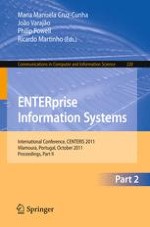This three-volume-set (CCIS 219, CCIS 220, and CCIS 221) constitutes the refereed proceedings of the International Conference on ENTERprise Information Systems, CENTERIS 2011, held in Vilamoura, Portugal, in September 2011. The approx. 120 revised full papers presented in the three volumes were carefully reviewed and selected from 180 submissions. The papers are organized in topical sections on knowledge society, EIS adoption and design, EIS implementation and impact, EIS applications, social aspects and IS in education, IT/IS management, telemedicine and imaging technologies, healthcare information management, medical records and business processes, decision support systems and business intelligence in health and social care contexts, architectures and emerging technologies in healthcare organizations, as well as m-health.
